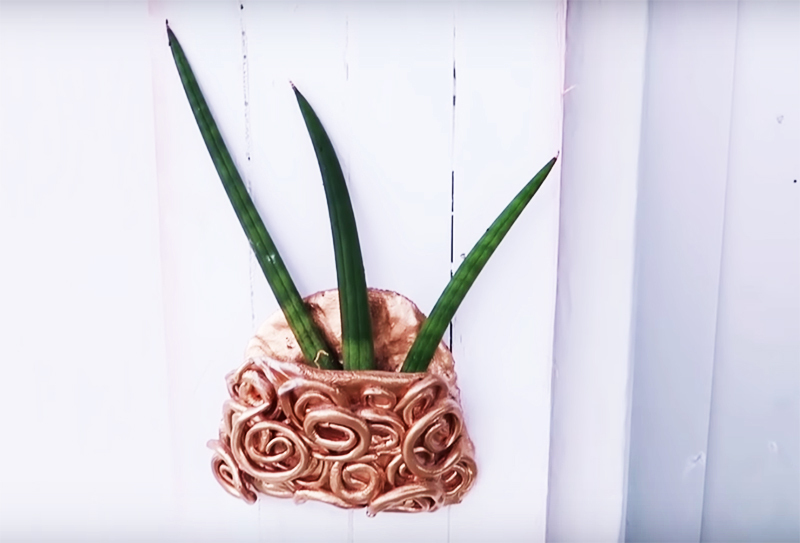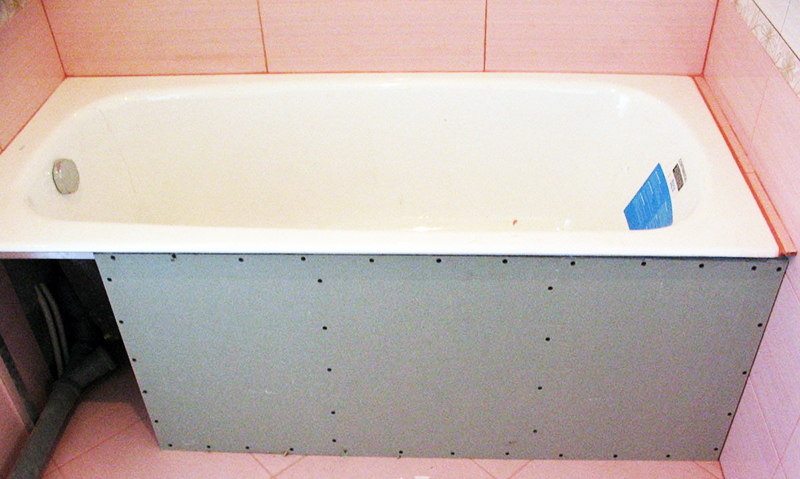Contents:
- Types of clothes dryers, their features and selection rules
- The simplest wall-mounted or near-battery drying dryers
- Ceiling dryers for bathroom and balcony
Finding the right place for drying washed items often causes headaches in many housewives. If cheap options are not suitable, and allocate funds from the family budget for expensive structures do not want, then the output will be a dryer for their own hands. Home craftsmen, even from improvised materials, are able to create a real masterpiece that will please not only its practicality, but also its attractive appearance. Even those people who can not boast of carpentry or architectural skills, are able to make a decent adaptation. It is only necessary to choose the optimal version of the product and follow the detailed instructions.
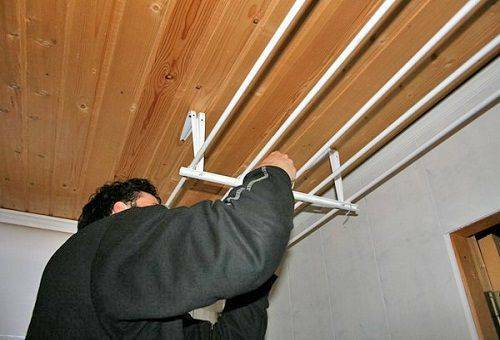
Types of clothes dryers, their features and selection rules
There are several options for classifying dryers that help owners make the right decision the first time:
- By type of placement. Can be ceiling, wall and floor. The first option is most often installed on the balcony and does not take up much space. The second one is considered universal and allows to establish the optimum height of the product location. The third one is the most ergonomic and usually implies a considerable area, which allows to dry many things at once.
- By type of fixation. Stationary and portable. With the first there are no questions about storage, but the latter can be rearranged if they interfere.
- By type of functionality. Folding, retractable and fixed. Even alone you can come up with a system that will allow you to unfold or slide the device only when you need to dry the laundry.
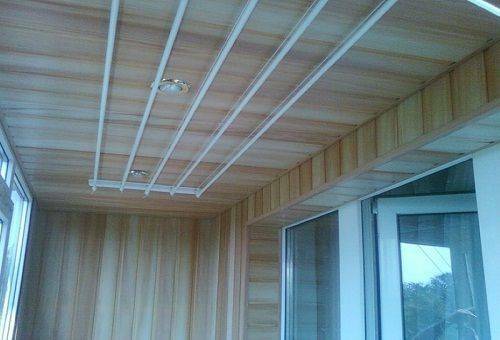
Ceiling dryer for the balcony
board Before you begin to design the product, you must precisely locate its location( if it is a stationary model).In addition, you should make sure that you can work with the chosen surface, otherwise you will have to run around the apartment with a blank and think out where to hang it.
The easiest clothes dryer with wall or near the
battery. In the bathroom or on the balcony, you can hang a wall-mounted foldable product that will occupy the minimum space when assembled. However, it is worth considering that you can not make it too massive. It is ideal for those who wash often, but little by little.
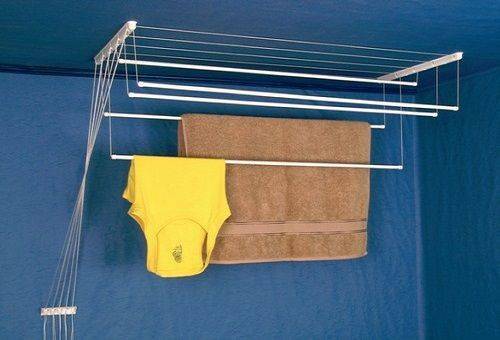
wall dryer The process consists of the following steps:
- First you need to prepare all the necessary tools and materials. These are several wooden rods( for creating rows) and four beams, furniture loops, a large board, several hooks, a fixer, a drill, nails, screws, paint.
- First you need to make a frame of beams with rods. To do this, we insert the bars into parallel bars, preliminary sharpening their ends and drilling holes in the tree. All the elements are fastened with screws.
- The size of the board is adjusted to the size of the frame, leaving a length of 15 extra centimeters. We fix the frame to the board with furniture loops, we check that the design is opened by 90º( in the closed state, both elements must coincide in the upper part).
- We give the product a decent look with the help of paint. In its upper part we attach a reliable lock.
- On the remaining centimeters at the bottom of the board we have hooks.
- We hang the device on the wall.
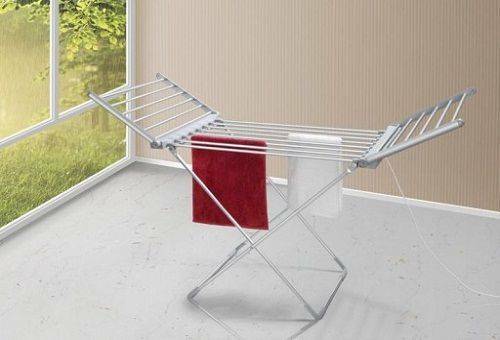
Floor-standing folding dryer
It is even easier to make a compact portable dryer that can be placed near the battery to speed up the drying process:
- We need two panels of chipboard, the height of which is adjusted to the height of the batteries, several metal tubes of small diameter, wooden spikes( twice as many as the number of pipes), glue, drill. In addition, we take at least three larger pipes and plugs to them.
- In the upper parts of the panels, make blind holes at the same distance from each other. Fill them with glue, insert spikes and install pipes. We wait until everything is dry.
- In addition, along the length of the panels we make three through holes, into which we insert large pipes and fix the plugs. This will allow the product to keep its shape.
Despite the simplicity of these approaches, any technical inaccuracy can adversely affect the quality of the product. Acting must be carefully and measuredly, without missing important milestones.
Ceiling dryers for bathroom and balcony
The use of ceiling dryers is considered the simplest solution to this issue. The structures, which are attached to the walls and stretch directly under the ceiling, practically do not conceal space, require a minimum set of materials. Their installation takes quite a bit of time.
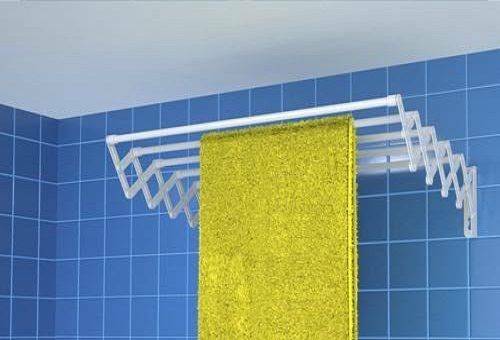
Drier-accordion in the bathroom
To make a dryer in the bathroom, you need to perform the following manipulations:
- Take some beautiful hooks on the screws. They should be an even number. In addition, we only need cuts of a beautiful and strong rope or a thin rope.
- On the opposite walls, almost under the ceiling, we make symmetrical markings. Extreme elements should not extend beyond the edges of the bath.
- We drill the walls in the established places, we insert hooks into the holes. We connect them with ropes, which securely tie and tighten.
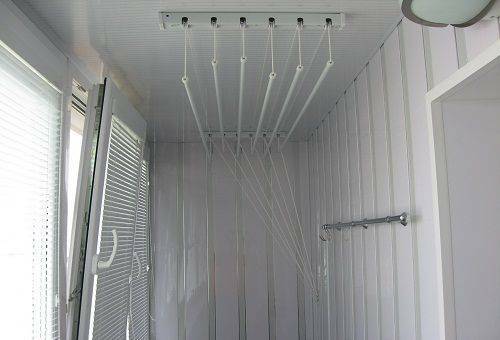
Ceiling dryer
The dryer on the balcony is done according to the following principle:
- We need two identical cuts of a metal pipe with a diameter of at least 3 cm, 4 blocks of wood + a wooden bar, several springs and rope cuts. In addition, you can take care of the decorative panel.
- The bars will function as brackets. They are attached to the ends of each pipe by a blind method, after which the structures are fixed at opposite ends of the balcony.
- In one pipe we drill holes through which we pass ropes and securely tie them with knots, fixing them at the ends. We stretch the cuts across the entire balcony and bend it through the second pipe.
- Loose ends are tied to the springs, which are attached to a pre-nailed to the wall strap. The design can be covered with a decorative panel, it will be better if it can be removed if desired. In this case, the stretched ropes will be tightened as needed.
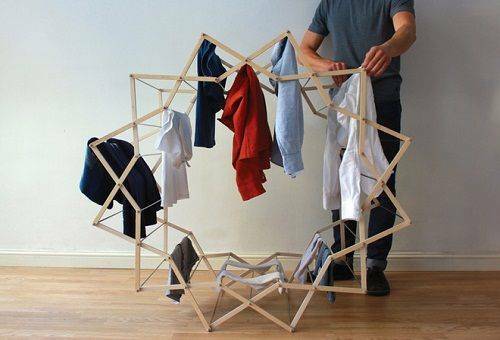
Original portable dryer
These are the simplest variations on the theme of home-made dryers. If desired, they can be improved, increasing the functionality and practicality. Particular attention should be paid to materials, they must be water resistant, lightweight and durable. It is not necessary to hurry up in work, it is better to think everything over and implement it in a qualitative way than to constantly repair and correct shortcomings.

